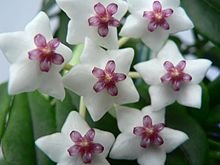Hoya carnosa, the porcelainflower or wax plant, is an Asclepiad species of flowering plant in the dogbane family Apocynaceae. It is one of the many species of hoya that are native to Eastern Asia and Australia. It is a common house plant grown for its attractive waxy foliage, and sweetly scented flowers.
.jpg)
Though many swear Hoya plant care is among the easiest of all indoor plants, we’ve cared for many Hoyas in the nursery over the years, and have learned that each has its specific likes and dislikes. Here are 5 of our favorite Hoya cultivars and their care requirements. We’ll move through from most to least common, so you can master the ins and outs of Hoya plant care. Plus, we’ll share a tip to induce blossoming.

The flowers are typically light pink, but may vary from near-white to dark pink; they are star-shaped, and are borne in clusters that look like tiny wax miniatures. The surface of the flowers is covered in tiny hairs giving them a fuzzy sheen. They are heavily scented and may produce excess nectar that drips from the flowers. Like all Hoyas, this species flowers from specialized perennial structures referred to as spurs. These appear from the axils of the leaves and stem; flowers may not be produced when the spurs first appear, but in time buds emerge from the tips. Each season new flowers are produced on these same spurs, so they should not be damaged or removed.
H. carnosa has been in cultivation for more than 200 years and has given rise to many cultivars that vary in foliage form or flower color. In cultivation in the UK it has gained the Royal Horticultural Society’s Award of Garden Merit.
Recent studies at the University of Georgia have shown H. carnosa to be an excellent remover of pollutants in the indoor environment.
